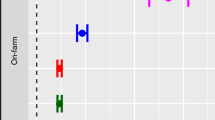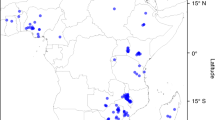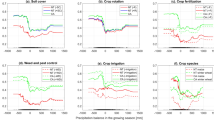Abstract
One of the primary challenges of our time is to feed a growing and more demanding world population with reduced external inputs and minimal environmental impacts, all under more variable and extreme climate conditions in the future1,2,3,4. Conservation agriculture represents a set of three crop management principles that has received strong international support to help address this challenge5,6, with recent conservation agriculture efforts focusing on smallholder farming systems in sub-Saharan Africa and South Asia7. However, conservation agriculture is highly debated, with respect to both its effects on crop yields8,9,10 and its applicability in different farming contexts7,11,12,13. Here we conduct a global meta-analysis using 5,463 paired yield observations from 610 studies to compare no-till, the original and central concept of conservation agriculture, with conventional tillage practices across 48 crops and 63 countries. Overall, our results show that no-till reduces yields, yet this response is variable and under certain conditions no-till can produce equivalent or greater yields than conventional tillage. Importantly, when no-till is combined with the other two conservation agriculture principles of residue retention and crop rotation, its negative impacts are minimized. Moreover, no-till in combination with the other two principles significantly increases rainfed crop productivity in dry climates, suggesting that it may become an important climate-change adaptation strategy for ever-drier regions of the world. However, any expansion of conservation agriculture should be done with caution in these areas, as implementation of the other two principles is often challenging in resource-poor and vulnerable smallholder farming systems, thereby increasing the likelihood of yield losses rather than gains. Although farming systems are multifunctional, and environmental and socio-economic factors need to be considered14,15,16, our analysis indicates that the potential contribution of no-till to the sustainable intensification of agriculture is more limited than often assumed.
This is a preview of subscription content, access via your institution
Access options
Subscribe to this journal
Receive 51 print issues and online access
$199.00 per year
only $3.90 per issue
Buy this article
- Purchase on Springer Link
- Instant access to full article PDF
Prices may be subject to local taxes which are calculated during checkout



Similar content being viewed by others
References
Foley, J. A. et al. Solutions for a cultivated planet. Nature 478, 337–342 (2011)
Lobell, D. B. et al. Prioritizing climate change adaptation needs for food security in 2030. Science 319, 607–610 (2008)
Godfray, H. C. J. & Garnett, T. Food security and sustainable intensification. Phil. Trans. R. Soc. B 369, 20120273 (2014)
Tilman, D., Balzer, C., Hill, J. & Befort, B. L. Global food demand and the sustainable intensification of agriculture. Proc. Natl Acad. Sci. USA 108, 20260–20264 (2011)
FAO. Save and Grow: A Policymaker’s Guide to the Sustainable Intensification of Smallholder Crop Production 1–37 (FAO, 2011)
Hobbs, P. R., Sayre, K. & Gupta, R. The role of conservation agriculture in sustainable agriculture. Phil. Trans. R. Soc. B 363, 543–555 (2008)
Stevenson, J. R., Serraj, R. & Cassman, K. G. Evaluating conservation agriculture for small-scale farmers in sub-Saharan Africa and South Asia. Agric. Ecosyst. Environ. 187, 1–10 (2014)
Giller, K. E., Witter, E., Corbeels, M. & Tittonell, P. Conservation agriculture and smallholder farming in Africa: the heretics’ view. Field Crops Res. 114, 23–34 (2009)
Rusinamhodzi, L. et al. A meta-analysis of long-term effects of conservation agriculture on maize grain yield under rain-fed conditions. Agron. Sust. Dev. 31, 657–673 (2011)
Brouder, S. M. & Gomez-Macpherson, H. The impact of conservation agriculture on smallholder agricultural yields: a scoping review of the evidence. Agric. Ecosyst. Environ. 187, 11–32 (2014)
Andersson, J. A. & Giller, K. E. in Contested Agronomy: Agricultural Research in a Changing World (eds Sumberg, J. & Thompson, J. ) Ch. 2 22–46 (Earthscan, 2012)
Giller, K. E. et al. A research agenda to explore the role of conservation agriculture in African smallholder farming systems. Field Crops Res. 124, 468–472 (2011)
Friedrich, T., Derpsch, R. & Kassam, A. Overview of the global spread of conservation agriculture. Field Actions Sci. Rep. 6, 1941 (2012)
Godfray, H. C. et al. Food security: the challenge of feeding 9 billion people. Science 327, 812–818 (2010)
Sachs, J. et al. Monitoring the world’s agriculture. Nature 466, 558–560 (2010)
Palm, C., Blanco-Canqui, H., DeClerck, F., Gatere, L. & Grace, P. Conservation agriculture and ecosystem services: An overview. Agric. Ecosyst. Environ. 187, 87–105 (2014)
Erenstein, O., Sayre, K., Wall, P., Hellin, J. & Dixon, J. Conservation agriculture in maize- and wheat- based systems in the (sub)tropics: lessons from adaptation initiatives in South Asia, Mexico, and Southern Africa. J. Sustain. Agric. 36, 180–206 (2012)
Grassini, P. & Cassman, K. G. High-yield maize with large net energy yield and small global warming intensity. Proc. Natl Acad. Sci. USA 109, 1074–1079 (2012)
Corbeels, M. et al. Understanding the impact and adoption of conservation agriculture in Africa: a multi-scale analysis. Agric. Ecosyst. Environ. 187, 155–170 (2014)
Serraj, R. & Siddique, K. H. M. Conservation agriculture in dry areas. Field Crops Res. 132, 1–6 (2012)
International Center for Research in the Dry Areas (ICARDA) Geoinformatics Unit. http://gu.icarda.org/en/ (2014)
Cook, B. I., Smerdon, J. E., Seager, R. & Coats, S. Global warming and 21st century drying. Clim. Dyn (in the press)
Dai, A. Increasing drought under global warming in observations and models. Nature Clim. Change 3, 52–58 (2013)
Farooq, M., Flower, K. C., Jabran, K., Wahid, A. & Siddique, K. H. M. Crop yield and weed management in conservation agriculture. Field Crops Res. 117, 172–183 (2011)
Govaerts, B. et al. Conservation agriculture and soil carbon sequestration: between myth and farmer reality. Crit. Rev. Plant Sci. 8, 97–122 (2009)
Erenstein, O. Crop residue mulching in tropical and semi-tropical countries: an evaluation of residue availability and other technological implications. Soil Tillage Res. 67, 115–133 (2002)
Hijmans, R. J., Cameron, S. E., Parra, J. L., Jones, P. G. & Jarvis, A. Very high resolution interpolated climate surfaces for global land areas. Int. J. Climatol. 25, 1965–1978 (2005)
UNEP. World Atlas of Desertification, 2nd edn (eds Middleton, N. & Thomas, D. ) (Edward Arnold, 1997)
Hedges, L. V., Gurevitch, J. & Curtis, P. S. The meta-analysis of response ratios in experimental ecology. Ecology 80, 1150–1156 (1999)
Adams, D. C., Gurevitch, J. & Rosenberg, M. S. Resampling tests for meta-analysis of ecological data. Ecology 78, 1277–1283 (1997)
R Core Team. R: A Language and Environment for Statistical Computing. http://www.R-project.org (R Foundation for Statistical Computing, 2013)
Canty, A. & Ripley, B. boot: Bootstrap R (S-Plus) Functions. R package v.1.3-11. (2014)
Acknowledgements
We are grateful to the National Key Science and Technology Project of China for supporting X.Q.L. with grant number 2014ZX07101-012.
Author information
Authors and Affiliations
Contributions
C.v.K., B.A.L., and X.Q.L. conceived the project. All authors contributed to the literature search, except N.v.G. and R.T.V. C.M.P., X.Q.L., J.L., K.J.v.G., B.A.L., and M.E.L. extracted data from publications and contributed to construction of the database. C.M.P., X.Q.L., K.J.v.G., and N.v.G. conducted analyses. C.M.P. and X.Q.L. wrote the manuscript draft and all authors contributed to interpretation of the results and writing of the final paper.
Corresponding author
Ethics declarations
Competing interests
The authors declare no competing financial interests.
Supplementary information
Supplementary Data
Database of yield comparisons used in the meta-analysis. (XLSX 470 kb)
Supplementary Information
List of references for publications used in the meta-analysis. (PDF 348 kb)
Rights and permissions
About this article
Cite this article
Pittelkow, C., Liang, X., Linquist, B. et al. Productivity limits and potentials of the principles of conservation agriculture. Nature 517, 365–368 (2015). https://doi.org/10.1038/nature13809
Received:
Accepted:
Published:
Issue Date:
DOI: https://doi.org/10.1038/nature13809
This article is cited by
-
Microbially mediated mechanisms underlie soil carbon accrual by conservation agriculture under decade-long warming
Nature Communications (2024)
-
Changes in soil microbial community and co-occurrence network after long-term no-tillage and mulching in dryland farming
Plant and Soil (2024)
-
Conservation Agriculture Impacts on Economic Profitability and Environmental Performance of Agroecosystems
Environmental Management (2024)
-
Faba Bean (Vicia faba L.) physiological, biochemical and agronomic traits responses to tillage systems under rainfed Mediterranean conditions
Vegetos (2024)
-
Reduced benefits of climate-smart agricultural policies from land-use spillovers
Nature Sustainability (2023)
Comments
By submitting a comment you agree to abide by our Terms and Community Guidelines. If you find something abusive or that does not comply with our terms or guidelines please flag it as inappropriate.



